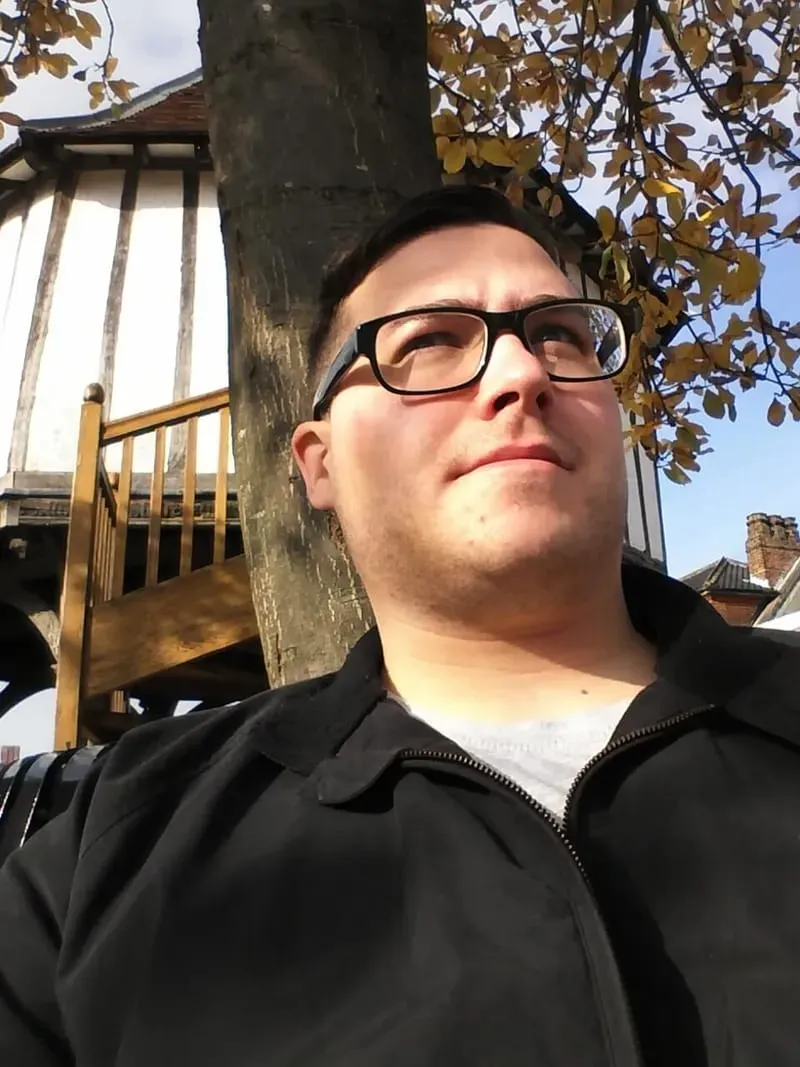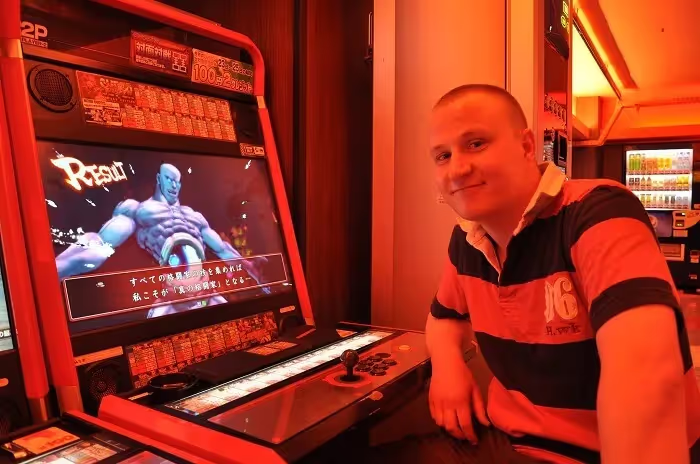Beyond Arcadia is a three-part series charting the impact that Dontnod's 2015 narrative-driven adventure had on its players. We chatted to numerous fans from across the globe to find out how the game and its story affected them, both during play and in their personal lives.
You can find Part 1 here.
Spoiler warning: this article contains major story spoilers for the original Life Is Strange, and general spoilers for the Life Is Strange franchise.
Soria
Hailing from Frankfurt am Main, Germany, 29-year-old Soria describes herself as “a passionate cosplayer, fanfiction writer and gamer.” Telling me about her relationship with games, she says, “My life took on a very chaotic dimension at a very early age, and I’m now struggling with the long-term consequences of a severe traumatisation since the age of 13. That's one reason why games have such a big meaning in my life. They offer me a safe space in which I feel really comfortable.”

After learning some background information about Soria, I asked what her initial feelings were about the game: what she remembers from Life Is Strange’s launch in 2015 and what really grabbed her.
“I played Life Is Strange for the first time shortly after the first episode was released in 2015. A well known German YouTuber had played it and I was immediately so in love with the graphics and soundtrack that I decided after only 10 minutes to buy and play it by myself. One of the best decisions of my life,” she explains.
Remembering the opening scenes, she continues, “It was a really wild ride that I didn't expect because the game started, after this strange scene with this big storm, so calm and innocent. Just like a normal life. But already after the first 30 minutes I realised why the game was called Life Is Strange. At this point, I started to think that this game will be something very special. The extreme change as soon as you entered the bathroom with Max literally left me speechless.”

The game certainly has a unique opening. One of the best in video games, this author thinks, and Soria was equally captured by the magic. “Most games, especially story-based games, usually start quietly and increase slowly. But here the developers have done something that very few games have managed to do for me. I was so caught up in this world and its story after less than an hour of playing. I was so desperate to know what was going to happen next. But since the first episode just came out, I always had to wait 3-4 months for each subsequent episode. I killed that time by playing the previous episodes over and over again.”
You would think replaying part of a game repeatedly would get boring, but not to Soria, who found the player agency of Life Is Strange’s world extremely compelling. “Each time it was incredibly intense and beautiful because there were so many details to discover and possibilities that gave the characters and the story additional depth. Also, the fact that you could define Max as a character by the possibilities of answers and behaviour was a very big plus for me. At the beginning, I didn't really notice how much love the developers put into the development of each character. Every single one of them has their own story, which shows itself through its behaviour. And just like in real life, you can only see why some characters acted the way they did if you’re watching closely.”
The rich characters and their story arcs were a big draw for Soria, then, and she gives the example of the game’s Nathan Prescott to illustrate her point. “At first you think he's just a rich, spoiled asshole. I really didn't like him at all. But the voicemail from Nathan to Max in episode five broke my heart,” she says choking up due to the sheer emotional impact of the scene. “Within a few seconds, the whole picture that Nathan gave me up to that point collapsed. He wasn't just being an asshole. He was a broken and deeply desperate teenager struggling with a bunch of problems all by himself. With parents who weren't interested in him, friends who only wanted his money and a teacher who used him as a shield for his pathological art.”

Soria cites David, Chloe’s stepfather, as another character that is more than a two-dimensional stereotype. “He was portrayed in the entire playthrough solely from Chloe's perspective. The bad man who's supposed to replace the late father, just bitching and moaning and making your life miserable. But in the end, he was the hero who freed Max and Victoria from the dark room and put Jefferson behind bars. That was such a beautiful message.”
The game's episode five dark room scene was a scene that hit particularly hard. “It was something completely different to accompany Max through this nightmare. My hands were sweating, and I am an absolute fan of horror games like Outlast. But the developers managed to make this episode so uncomfortable that it didn't need classic horror to make your feel this way. Not everyone dares to illustrate such a scene and for that I admire the developers. I was also tied to a chair for a cosplay shooting for Life Is Strange. Voluntarily, of course, I wanted to do that, but it was still unpleasant.”
Moving on to the final decision in the game and Soria agonised over the choice of who to save. “My heart was ripped into a thousand pieces as I faced the final decision. I cried and could barely read the answers. I felt so sorry for Max. Either you sacrifice the life of your love/best friend, which you have tried to protect and save all the time, or you sacrifice the lives of so many innocent people for the person you love.”

“It was really hard, but I sacrificed Chloe in my first run because it was the right thing to do, and yet I felt bad because everything you fought for in the game was lost — except for Max's memories of it,” she continues. “I was hoping the other end would be a happy ending, but the ending where Chloe lives left an even more bitter taste in my mouth. And even though the first ending hit me more emotionally than the second, it was the better ending. It wouldn't be fair for one person to sacrifice dozens of others, no matter how painful the loss of a loved one might be.”
But these aren’t just video game musings to Soria, they’re life lessons; life lessons that make up part of Life Is Strange’s charm to so many. “It shows what life is like. Decisions are never easy. Decisions can make all sorts of difference, positive or negative. They cause suffering and hate, but they also cause joy and love. Yin and yang. No shadow without light. Everyone probably knows the thought of ‘what would have happened if I had acted differently back then?’. Dontnod has left a strong message here: that it is okay to make wrong decisions. It is never a good feeling to know that you did something ‘wrong’. What is important is how you deal with it and what you learn from it for the future. Because even if the story is only fictional and things like turning back time don't exist, here you have the possibility to experience that it doesn't help to change the past. If you prevent a bad event, the next one follows at the next corner.”
It’s clear that Life Is Strange means a lot to her, so I asked Soria how the game’s impact manifested tangibly in her life. “Life Is Strange has taught me a lot about social contacts and the behaviour of people. Also, the story has shown me that people have a huge problem with prejudice. I grew up with prejudices and I just carried them on bluntly because I didn't think about what my words and actions could do. Through Life Is Strange I could learn a lot; become a better version of myself.” To add to that, she compares the experience of playing the game to that of therapy for her.

But it’s not just the game itself, it’s the community that surrounds Dontnod’s title that she can connect with, too. “Through the Life Is Strange community I met many acquaintances and even some good friends. We got to know each other at conventions or through photo shoots for Life Is Strange, and we had so much fun together that even now, six years later, we are in contact. I still like to look at our pictures again and again because there are so many nice memories connected to them. Within this community it's easy for me to talk to strangers because all the other cosplayers and fans were so nice and sweet to each other. Altogether, Life Is Strange created a beautiful fanbase, which behaves, most of the time, respectfully and nicely.”
One thing the game seems to be to its fans is relatable, in one way or another, and it's no different for Soria. “I know Chloe can be considered rude and ungrateful, but I recognised my teenage self in her. Pissed off at everything and everyone because you feel abandoned by everyone,” she expresses to me. “First her dad dies in a car accident and then her best friend leaves. Then there was Rachel, who simply disappeared without a word. I was forgotten by friends too. They vanished quietly out of my life without reason, without explanation — and that hurts. Especially when it happens again and again and you don't know why. You become bitter and Chloe clearly shows this behaviour.”
But the similarities don’t end there, as Soria continues. “[Max] helps her to heal, and this is also something I have experienced in my life. Other people can help you to deal with personal problems. To process them better, instead of suppressing them. That simple feeling of not being alone, of having someone who is there for you, someone you trust. It can take a great weight from your shoulders. My girlfriend is my rock in the surf who catches me when I can no longer manage things on my own, without judging why I can't manage ‘normal’ things, like working, at the moment.”

Soria has been in a same-sex relationship with her girlfriend for eight years now and feels this aspect of Life Is Strange was handled in a respectful manner. “It was an incredibly nice feeling for me when I realized that Max and Chloe can build up a romantic relationship. They have portrayed the LGBT+ community in a very normal and natural way and brought it into their story without advertising it or without it feeling forced.”
Politics in video games has always been a contentious topic, but Soria thinks that Dontnod’s explicit tackling of social issues in their franchise is something that we should applaud them for. “Dontnod has really reached deep into the social criticism box, and I think that's incredibly courageous. Police violence, racism, discrimination, bullying, ignorance, selfish people, all of them are big aspects of society, which has been a huge problem all over the world for decades and it's talked down everywhere. I really admire Dontnod for this because, especially in this time, understanding racism and all the other issues has become even more important. Suddenly, you can experience the world the way migrants or people who look ‘foreign’ or simply don't fit into society do. One experiences the systematic discrimination of these people and gets an insight into what it means to be helplessly exposed to racism and discrimination.”
From these interviews, it’s clear that Life Is Strange has much to tell us about the real world, too, if we’re willing to listen, and one of the last things Soria leaves me with is a testament to that.
“Game designers are storytellers, and if we listen carefully to their stories, we can learn a lot from them.”
Cain
Cain, 37 and from the East of England, is the creator of the Arcadia Club Twitter account, which he describes as “a community hub for fans of the Life Is Strange game series and everything that ties in with that.”

A latecomer to the game, Cain’s first Life Is Strange experience was two years ago, when he saw footage of the game. “I was drawn immediately to Life Is Strange from having seen the trailer with Max and Chloe in the bathroom of the academy they both attend. I immediately loved the style, the tension and could tell that it was very character-driven.”
It’s the mish-mash of the supernatural and the humane elements of Life Is Strange that impressed Cain on his first playthrough. “I particularly like the horror elements, such as the maze, but also the touching intimate moments of friendship that Max and Chloe share throughout. There is tension, but you can tell they really do care about each other despite the time that has passed.”
It’s the characters and heavy narrative style that appeal to Cain. “I personally have always loved character-driven games. You can identify with the characters — their growing up, finding themselves and their sexualities, developing relationships and bonds, the uncertainties of life and the consequences of decision making, which is highly applicable in-game because your choices have an impact on the characters' relationships and what happens to them.”

I ask Cain about the game’s lasting impact, as I do with all of the interviewees, keen to find out just what a series such as this means to its fans. “The games have been incredible. They distract you from all the negative stuff going on in the world, which, let's face it, at the moment is a lot, and can be a great source of comfort, I think.” But the game also helped get him involved in a community of fans he would have never otherwise met. “Life Is Strange directly caused me to create the community hub, and it has been amazing interacting with fans from all over the world. I think the games and characters have a huge connection to the LGBT communities in particular. People see themselves in these characters and become very attached and protective of them. That can be a good and bad thing. In reality these games and characters belong to everybody who plays the games and enjoys them. I think sometimes people take things a little too far with being protective over what their interpretations of the games and characters are, but overall the experience has been a hugely positive one and I have many new friends thanks to Life Is Strange.”
“It's as relevant now as ever," Cain remarks when I ask him to reflect on how the title has aged in six years. "The story is great, the characters are great, people still identify with them. Plus, there are the comics adding to the story of the Life Is Strange universe and all the content that fans put out there. It's as alive now as it ever was.” But how does he think the original stacks up to the sequels? “The subsequent game Before the Storm has the same core although a slightly different feel to it. You can tell it's part of the same universe though and having the same graphical design is helpful in that. The soundtracks for both games are amazing too,” he says.
Like many who have played Life Is Strange, Cain also finds aspects of the game relatable, but in a different way from other fans. “We've all had a sense of confusion growing up. We've all had relationships that have been intimate, highly charged, and sometimes lost people we've loved. For me the game connects in another way, however. I was going through a slight depression at the time of playing and Life Is Strange became a source of comfort, positivity and motivation. It didn't really matter about the events of the game too much because just being in this universe with these characters was enough.”

As my time with Cain comes to an end, he speaks to me about the intangible siren’s call of Life Is Strange, and what makes it so different from most other games out there, something echoed by many fans I’ve spoken to.
“I think the Life Is Strange series is an amazing set of character-driven games. The stories have serious and fun elements that keep you hooked, the graphics are beautiful and the soundtrack really does connect to your soul in some sort of almost spiritual way. When you add this to all the other content out there, I think people will still be playing and loving even the original game in years to come. “
Kayleigh
Up until recently, Kayleigh, 18, was a hospitality and catering student, but now she’s looking to move into a writing role in the games industry. And her first Life Is Strange experience also came later after release. “I first played Life Is Strange two years ago on my Xbox. I downloaded it on a whim due to the first episode being free to play and the art catching my attention far beyond any other game I saw,” she tells me.
After downloading the game, she immediately connected with its ensemble cast. “Upon my first playthrough of the game, I found myself captivated by each of the characters. Whether it was Max because of her relatable dorky nature, Nathan because of his mysterious yet aggressive nature, or Chloe because of her rebellious yet caring nature. All of them as individuals have striking personality traits that make no character, even the smaller roles, the same.”

During the course of the game we never meet Rachel Amber, but Kayleigh thinks Dontnod excelled in getting you to care about the character nonetheless. “I felt I was emotionally connected to the story in terms of Rachel Amber. Albeit not seeing her throughout the game and the threat of a storm hitting Arcadia Bay, my main focus was always on Rachel Amber and what could have possibly happened to her. They did an incredible job at connecting you with her character and developing her story. Because of this, I couldn't put down my controller and continued to buy each episode and play through it over the course of a few days.”
Kayleigh also feels like Life Is Strange and its community has bettered her life in numerous ways. “The game has very positively impacted my life in terms of socialising. I have made an abundance of online friendships that I feel can't be broken. We connected through our mutual love for characters and grew attached. If it wasn't for this game, I'd never have met some of my best friends. As well as this, although this was already a hobby, the incredible writing of this series has inspired me to continue to build my own skill, after putting it aside for years to study food and growing rusty.”
Seems like you’re not just wasting your time with video games, after all.
Life Is Strange’s well-realised world keeps its fans coming back time after time, and it's no different for Kayleigh. “Even though it's been a good while since the game’s release, I can't bring myself to put down the controller when this game pops into my mind,” she says. “Despite knowing the ending, I can't help but feel drawn to playing through and learning as much as I can about characters over and over again, and growing to love each and every single one. As I said earlier, even the side characters have their own little stories that are amazing in their own right, and it really shows just how much care they put into the development of this beautiful game.”

Kayleigh's favourite game of the franchise is actually Before the Storm. “Whether this is due to my loyalty to Chloe Price as a character or the wrapping up of loose ends not previously discovered in the original game, I loved [Before the Storm]. I loved the final detail of the Farewell episode, where we got to learn more about Max. I love that we learnt more about Rachel Amber. Just like the original, I find it hard to put the game down once it's on my mind.” But she didn’t click with Life Is Strange 2. “I found it difficult to connect to the characters in Life Is Strange 2. As much as it's a good game in its own right, it didn't hit quite as hard for me as the first two games.”
A common feeling among fans I’ve interviewed is that of relatedness; the level of empathy they have with the game’s characters and the situation they find themselves in. “I find myself to be relatable to the character Chloe Price. Having lost important people in her life, and being unconditionally dedicated to who she does have, I feel myself drawn to her character,” Kayleigh explains. “Her family isn't quite broken down but not completely together due to the presence of David.”
“Sexuality wise — being attracted to girls — I also feel a connection on that front, too. Out of all the characters in the franchise, I have never felt more connected to anyone as I have Chloe Price. Honestly, in any game franchise in general.”
Nela
Nela is an 18-year-old student from small-town Austria.
“I played Life Is Strange for the first time in 2015,” she tells me when I ask about her first experience with the game and what stuck out to her. “I remember how in love I was with the art style. I’d never seen anything similar to it. It was quite simple yet so beautiful and detailed.” She left a few days between playing each episode so that she could “spend a few days thinking about what happened in the episode and speculating what might happen next.” It was the scenes of reflection and relaxation that Nela remembers most vividly. “I loved the quiet moments, where you could sit down as Max and the world just stopped moving for a moment.”

Nela, like other fans, also feels that Life Is Strange had a palpable impact on her life, which continues to this day. “The game has absolutely changed my life for the better. It might sound cheesy, but that’s how I feel,” she says. “I met my best friend over a year ago within the Life Is Strange community. We’ve been talking almost everyday since we met. I am so thankful that it brought me to him.” Like others, the game also helped Nela come to terms with her sexuality. “Through the game I also realised that I am attracted to girls as well. I never really thought about it before, but Max and Chloe’s relationship, or friendship, awoke that feeling in me.”
The game also helped reignite her passion for decade-old hobbies. “I’ve always been in love with photography. As a little kid I would walk around with my father’s camera to snap photos of literally anything that I thought was pretty. Over the years I’ve lost motivation to keep taking photos,” she reminisces.
“Everyone has phones with great cameras nowadays, and I thought they all looked better than mine. Life Is Strange reminded me how passionate I was about visual art; how it made me feel. It showed me that other people struggle with their photography as well, and just because photos are different doesn’t mean they’re less beautiful.”
I ask Nela how Life Is Strange compares to the sequels. “The original will always have a special place in my heart. It will always be unique to me. I wouldn’t say the other games have the same feeling, they’re quite different. I love them equally but for different reasons. If you asked me to rank them, I couldn’t answer. Sometimes I’m in the mood for the original game and what it stands for. Other times I have a strong feeling to dig back into the world and atmosphere of the other games.”

When I ask Nela about whether she relates to Life Is Strange and how, she responds, “What’s so special about Life Is Strange is that you can somehow connect and relate to multiple characters. I strongly relate to Max, who struggles with self-worth and confidence. She’s an empath who always tries to do everything in her power to do the right thing and help other people. At the same time I could relate to Kate, who felt left alone in this huge world. She felt misunderstood by everyone. I could go on and on about things and characters I relate to. I could always find that one aspect of their character or their lives to reflect mine.”
There certainly seems to be something so human about Dontnod’s characters and world-building that appeals to fans from a wide range of backgrounds, and it’s fascinating. But as my time with Nela ends, she reveals the life lessons the game imparted to her: soft skills.
“Life Is Strange taught me that even the smallest things can be huge to someone else. For example, I now pay much more attention to my friends' interests; what they tell me about their lives. It might mean a lot to people. Just like when Max helped Kate down from the roof by remembering small things about her friend's life. It also showed me that behind most troubled people, there is a cry for help. Take Nathan, for example. In my eyes he was not a bad person, and maybe if someone tried to be there for him and helped him out sooner things wouldn’t have ended the way they did. I always try to see behind the masks of everyday people’s faces.”
This is part two of three in a series about the lasting effects of Life Is Strange on its fans six years after release, and what we can learn and take away from their experiences. Part one can be found here.
Check back next Friday on Jump Dash Roll for the third and final part!
You can subscribe to Jump Chat Roll on your favourite podcast players including:
Let us know in the comments if you enjoyed this podcast, and if there are any topics you'd like to hear us tackle in future episodes!




